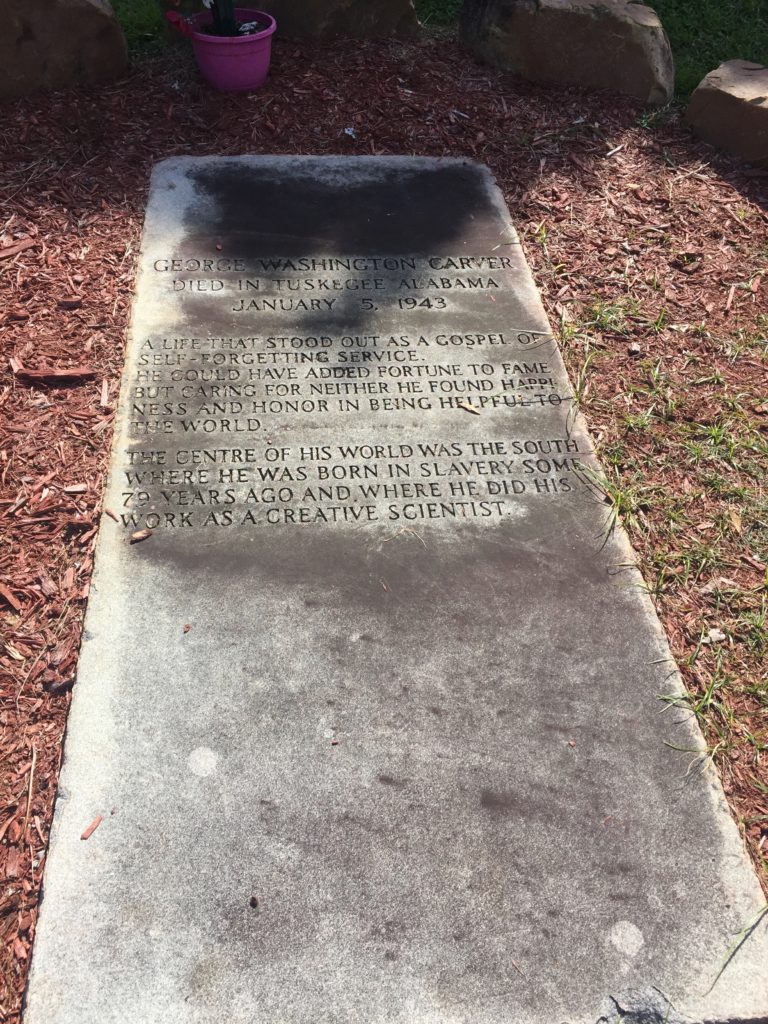Erik Visits an American Grave, Part 536
This is the grave of George Washington Carver.

Carver was born at some unknown date during or perhaps just before the Civil War, a slave near Diamond, Missouri. His master was a small-time slave owner named Moses Carver, a German immigrant who had purchased the boy’s parents before the war. Near the end of the war, as slavery was close to being abolished in Missouri, Carver, his mother, and his sister, were all kidnapped and sold in Kentucky. Carver’s master tried to find his lost property, but only found George. Carver thus never knew his mother or sister. His father died before he was born. Once slavery ended, Carver’s former master at least somewhat took care of the boy and his brother, who had escaped the kidnapping raid. They encouraged him to get an education. He was quite keen at that idea. At the age of 13 or so, he went to Kansas to attend a school. There, he witnessed a group of white men murder a black man. This was sadly common in post-Civil War America.
Carver wanted to attend college, but had trouble finding one who would let him in due to white supremacy. He finally was accepted at Highland University of Kansas, but when he arrived, they wouldn’t let him take classes because he was black. Frustrated by his attempts to get a formal education, Carver homesteaded a piece of land for the next few years, raising enough crops to get by and doing extra work for money. He finally got to college in 1890, at Simpson College in Iowa and then at Iowa State College, today Iowa State University. He studied art and piano at the former and agriculture at the latter, where he was the first black student to ever attend. He then received his master’s at Iowa State and then was hired to teach plant science.
In 1896, Booker T. Washington invited Carver to move to Tuskegee Institute and lead that college’s agriculture department. He agreed and taught there for the next 47 years. Many of other professors there hated him, thinking him arrogant and resenting the fact that he negotiated a better salary and living quarters than they had. By many accounts he was a difficult guy, but whatever. In any case, he was one of the best agricultural scientists in the country, doing work on all sorts of crops, including sweet potatoes, soybeans, pecans, and most famously, peanuts. His real specialty was crop rotation and soil conservation, a hugely important issue in the South where cotton production had created epic levels of erosion in the lands around Tuskegee (including Providence Canyon, now considered one of the “seven natural wonders of Georgia.” Hmmm….). These soy and nut crops were useful in nitrogen fixing, rejuvenating the soil for cotton in the future.
Carver became famous for his work. He was obviously brilliant and even given the racism of the day, that brilliance gave him some access to power. Theodore Roosevelt knew and respected his work. Some of his professors at Iowa State were named Secretary of Agriculture. Despite outrage from southern congressmen, Carver testified before Congress on peanut production in 1921, leading to a tariff on imported peanuts to protect the growing American industry in the crop. He met with Theodore Roosevelt, Calvin Coolidge, and Franklin Roosevelt.
One key thing does need to be mentioned. Carver did not invent peanut butter, still a widely held belief. There are a few people who can claim this invention, though Native people had created a proto-peanut butter long before, but Carver had nothing to do with it. He did take out patents on a couple of things, but none of them were commercially successful. He came up with lots of products for his crops, but none of them were particularly famous, though he did spread recipes for once odd crops such as peanuts to convince farmers to grow them, and land owners to let tenants and sharecroppers do so. He also had a remarkably high voice, leading some to speculate that he had been castrated while a young boy. But despite the horrific treatment that African-Americans were subjected to, the evidence for this is highly sketchy and probably should be dismissed.
In 1943, just after New Year’s, Carver fell down a flight of stairs. He never recovered and died soon after.
In the end, Carver’s myth is bigger than the man. What he should be known for is two things. First, the remarkable success he had as an African-American man whose life spanned the horrors of slavery and Jim Crow. Second, his pioneering work in soil conservation and agricultural diversification that has helped create a more robust and sustainable farming economy in the nation. Sure, that has been undermined by the corporate control over rural land, but that’s hardly Carver’s fault.
George Washington Carver is buried at Tuskegee University, Tuskegee, Alabama.
This grave visit was supported by LGM reader contributions. Many thanks to all who keep this series alive! If you would like me to visit more famous African-Americans of Carver’s generation, you can donate to cover the required expenses here. Scott Joplin is in Queens and pioneering diplomat George Washington Buckner is in Evansville, Indiana. Previous posts in this series are archived here.


